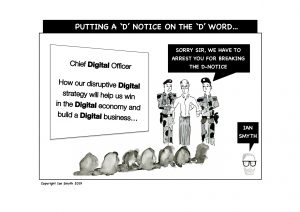- Call: 0203 427 3507
- Email: innovation@clustre.net

At a recent conference – organised by Skillsoft, the world’s leading provider of eLearning solutions – I suggested to the large audience attending my panel session that we should ban the ‘D’ word. And ‘D’ stands for Digital – the most over-exercised word in today’s tech vocabulary.
Judging by the rousing cheer to this suggestion, I am not alone in wanting this ban. So, in an attempt to make the ban stick, I have decided to invoke the ‘D’ Notice – a curiously British institution which The Guardian newspaper describes as: ‘a sort of not quite public yet not quite secret arrangement between government and media in order to ensure that journalists do not endanger national security’.
Joking apart, let me explain why I take this matter seriously.
I fear that we suffer from Digital madness. We have Digital strategies… Digital leaders… Digital journeys… Digital transformations… and leading this unstoppable digital invasion is the Chief Digital Officer. (Not to be confused with the other CDO – the Chief Data Officer).
So, what’s wrong with all this hype around Digital?
Well, the blunt answer is that it deflects attention away from a much greater priority. Digital may be passion but it’s not where we should be focusing our efforts and energies. Instead, we need to concentrate on achieving a better and more sustainable business – albeit one that is supported and empowered by Digital.
Undeniably, we are in a Digital age. Equally clearly, we are also in a very disruptive era where every organisation and industry (whether digitally enabled or not) is under threat. Just the other day this truth was made shockingly real when the mighty British Steel collapsed – as did Jamie Oliver’s chain of restaurants. These two businesses were not the victims of a digital war; they were casualties of a much more profound and fundamental business problem. Disruptive change is probing and pressuring the resilience of every business model. It’s also stress-testing relationships with customers, employees, suppliers and all key stakeholders.
I know this will be contentious but I stand by it: Companies don’t need Digital Strategies. Instead, they need to update their Business Strategies for the digital age (why on earth would anyone want two strategies when getting one right is difficult enough?). Companies need to focus, in the first instance, on which parts of their business to digitise and how best to go about it. And the answer to those critical questions will come from some really honest self-analysis:
These are the fundamental questions we should be asking – and answering – before we bring the ‘D’ word into the conversation.
Finally, I have one last piece of advice for companies that genuinely want to transform themselves. In a world of increasing complexity, it pays to think of E to the power of three: E³. To make it EEEasy for everyone, focus on improving:
Good luck and don’t wait for my ‘D’ notice to surface.
Robert Baldock, MD, Clustre – The Innovation Brokers
Learn more… for more advice on how to move your business forward and embrace digital, simply email innovation@clustre.net